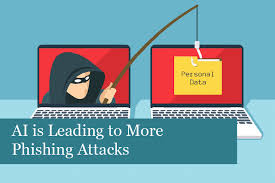Cybercriminals are increasingly using advanced AI, including tools like ChatGPT, to execute highly convincing phishing campaigns that mimic legitimate communications with uncanny accuracy. As AI-powered phishing becomes more sophisticated, cybersecurity practitioners must adopt AI and machine learning defenses to stay ahead.
What are AI-Powered Phishing Attacks?
Phishing, a long-standing cybersecurity issue, has evolved from crude scams into refined attacks that can mimic trusted entities like Amazon, postal services, or colleagues. Leveraging social engineering, these scams trick people into clicking malicious links, downloading harmful files, or sharing sensitive information. However, AI is elevating this threat by making phishing attacks more convincing, timely, and challenging to detect.
General Phishing Attacks
Traditionally, phishing emails were often easy to spot due to grammatical errors or poor formatting. AI, however, eliminates these mistakes, creating messages that appear professionally written. Additionally, AI language models can gather real-time data from news and corporate sites, embedding relevant details that create urgency and heighten the attack’s credibility.
AI chatbots can also generate business email compromise attacks or whaling campaigns at a massive scale, boosting both the volume and sophistication of these threats.
Spear Phishing
Spear phishing involves targeting specific individuals with highly customized messages based on data gathered from social media or data breaches. AI has supercharged this tactic, enabling attackers to craft convincing, personalized emails almost instantly. During a cybersecurity study, AI-generated phishing emails outperformed human-crafted ones in terms of convincing recipients to click on malicious links. With the help of large language models (LLMs), attackers can create hyper-personalized emails and even deepfake phone calls and videos.
Vishing and Deepfakes
Vishing, or voice phishing, is another tactic on the rise. Traditionally, attackers would impersonate someone like a company executive or trusted colleague over the phone. With AI, they can now create deepfake audio to mimic a specific person’s voice, making it even harder for victims to discern authenticity. For example, an employee may receive a voice message that sounds exactly like their CFO, urgently requesting a bank transfer.
How to Defend Against AI-Driven Phishing Attacks
As AI-driven phishing becomes more prevalent, organizations should adopt the following defense strategies:
- Security Awareness Training: Regularly educate employees on identifying phishing attempts, covering both traditional and AI-enhanced techniques.
- Recognize Red Flags: Phishing emails may evoke urgency, contain suspicious links, or come from slight variations in trusted email addresses.
- Be Cautious with Links and Attachments: Avoid clicking links or downloading files from unknown sources. Verify any suspicious messages through trusted channels.
- Use Multi-Factor Authentication (MFA): MFA can block unauthorized access even if login credentials are compromised.
- Deploy Email Security Tools: Email filters, firewalls, and antivirus software can prevent many phishing attempts from reaching inboxes.
- Implement Email Security Protocols: Secure protocols such as DMARC, SPF, and TLS add layers of authenticity to email communications, making it harder for attackers to impersonate trusted contacts.
- Use AI for Threat Detection: Defensive AI can be trained to detect patterns and characteristics common to phishing emails, providing additional layers of protection.
How AI Improves Phishing Defense
AI can also bolster phishing defenses by analyzing threat patterns, personalizing training, and monitoring for suspicious activity. GenAI, for instance, can tailor training to individual users’ weaknesses, offer timely phishing simulations, and assess each person’s learning needs to enhance cybersecurity awareness.
AI can also predict potential phishing trends based on data such as attack frequency across industries, geographical locations, and types of targets. These insights allow security teams to anticipate attacks and proactively adapt defenses.
Preparing for AI-Enhanced Phishing Threats
Businesses should evaluate their risk level and implement corresponding safeguards:
- Understand AI’s Asymmetrical Threats: While AI empowers both attackers and defenders, phishing’s psychological manipulation often gives attackers an edge. Educating users remains challenging but necessary.
- Assess Organizational Threat Level: Identify and classify the organization’s phishing risk level to allocate adequate resources.
- Evaluate Phishing Awareness Programs: Periodically review and enhance phishing prevention and response plans, ensuring they evolve alongside the advancing AI threat.
AI, and particularly LLMs, are transforming phishing attacks, making them more dangerous and harder to detect. As digital footprints grow and personalized data becomes more accessible, phishing attacks will continue to evolve, including falsified voice and video messages that can trick even the most vigilant employees. By proactively integrating AI defenses, organizations can better protect against these advanced phishing threats.













